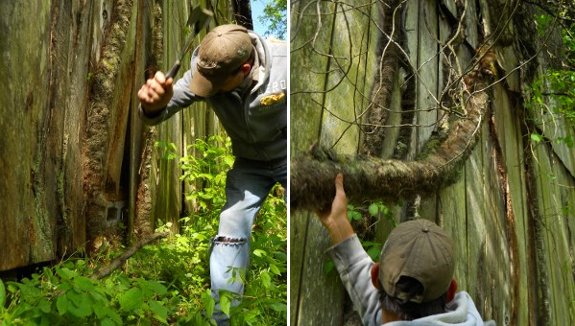
Barn damage due to poison ivy vines?

Turns out some of the structural
damage to our barn was due to poison ivy vines.
The vines were exposed to
falling water, which got conducted to various spots for what I'm
guessing is decades.
It wasn't a problem for our
new hired hand. He's been immune to the effects of poison ivy since he
was a kid.
Want more in-depth information? Browse through our books.
Or explore more posts by date or by subject.
About us: Anna Hess and Mark Hamilton spent over a decade living self-sufficiently in the mountains of Virginia before moving north to start over from scratch in the foothills of Ohio. They've experimented with permaculture, no-till gardening, trailersteading, home-based microbusinesses and much more, writing about their adventures in both blogs and books.
Want to be notified when new comments are posted on this page? Click on the RSS button after you add a comment to subscribe to the comment feed, or simply check the box beside "email replies to me" while writing your comment.

Back in 1970 I was maintaining a piece of property inland from Pescadero, CA which had a lot of Poison Oak on it. We were trying to get rid of it by digging it up. The roots were as big as the branch in your picture with with an outer layer that pulled loose easily and bled sap all over you. I used a tincture of the leaves that I got from a local pharmacy, starting with 5 drops in a glass of water per day and building up to 30 or so to prevent all itching and rash. The commercial product isn't available any more but there are directions for making your own and at least some pharmacies will make it for you.
Links:
Try a google search for "poison oak tincture oral hyposensitization"
http://www.poisonivyprevention.com/graphics/rhustoxsolution.pdf
http://www.ijpc.com/rxtriad/pdf/RxTriad_V11_N08_Sample.pdf
http://poisonivy.aesir.com/view/comments.html?func=showMessage&mid=131123&wid=279
http://www.henriettesherbal.com/eclectic/kings/toxicodendron_tinc.html
This sounds somewhat scary but the only side effects I have heard about were some reports of pruritis ani which seem to be associated with use of oil based solutions rather than alcohol based ones, which are absorbed faster and not expelled where they get onto the skin.
It makes me itch just looking at it! I must admit I have a terrible fear of poison ivy, and I wish I could convince myself it was irrational, but my mum has become so allergic to the stuff that she was horribly sick most of last summer (as in a rash over most of her torso and face, plus nausea, exhaustion, etc.), and that was just from petting cats who had rubbed up against it. When I suit up to go pull poison ivy (which I pretty much have to do a couple times a year), I look like I'm on some kind of haz-mat team!
Which is a long way of saying that those poison ivy logs are pretty terrifying and I'm glad that it's not my job to deal with them!
I actually told Bradley something very much like what Sheila said (although not so extreme), and he replied that he used to be allergic to poison ivy. He got into it so badly as a kid that he had to have a steroid shot, and he hasn't gotten it since. I didn't realize poison ivy allergies could go in that direction (overexposure making them less, not more), but that may be similar to what John is writing about.
Ikwig --- I'll be hoping you stay out of poison ivy! My mom's a bit like that --- she barely has to look at the plants and she'll get a rash.
MamaHomesteader --- Probably a good thing you don't live there any more.
My experience with other sensitizers (especially epoxy resins and hardeners) is that once your immune system starts to repond to the material, it doesn't go away. And with repeated exposure, the reaction gets worse.
When handling plants that contain urushiol, it is best to adhere to the clean working practices commonly used when handling irritants;
I hope those vines haven't actually become a structural element of the barn themselves over time!
I get poison oak out on the West coast just by looking at it, but on our recent trip out your way, I purposely rubbed poison ivy on my forearm and waited to see what happened after a set number of time increments and had no reaction! Thrilled to not be allergic to it (at least at this point in my life).
Roland --- That's what I'd always heard too --- that your resistance could go away with prolonged exposure. I used to be 100% not allergic, but have noticed in recent years that I do get a very small rash if I'm exposed now.
Mitsy --- Bradley shored up that area just in case.... Glad to hear you're immune to poison ivy!
Another thing to be concerned about is disposal of any branches or roots that accumulate from clearing your property. If you attempt to burn them or if they are piled anywhere that fire could get to them, you should be aware that the oils can be carried in the smoke and cause problems if inhaled or deposited on the skin.
A good source of information on dealing with these plants would be anyone in the forest service who has dealt with them in the context of forest fires.